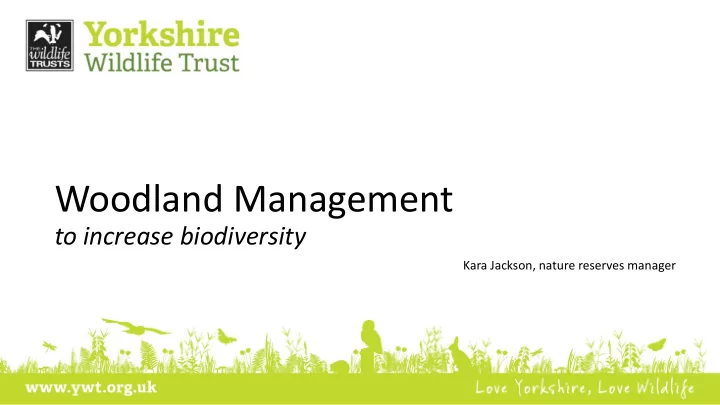

Woodland Management to increase biodiversity Kara Jackson, nature reserves manager
• First site in 1946 ….
From tiny acorns… • 40,000 members • 800 volunteers, working 52,288 hours! • 80 staff • 530 sheep, 138 cows, 3 dogs and a few ponies • 102 nature reserves Source: YWT 2013-14 Annual review
Woodland Management Techniques • Coppicing • Pollarding • Glades and Rides • Selective thinning
Grass Wood • At 78 ha, Grass Wood is one of the largest areas of broadleaved woodland in the Dales. It is a wildlife-rich ash woodland occupying an area of carboniferous limestone on the north side of Wharfedale. • Ride creation • Felling of plantation species • Planting up with broadleaf, native species
Hetchell Woods - Coppicing • Improve the wildlife value of the habitat. • rotational cutting, one section per year around the woodland, over a long period. • The cut coppice is stimulated to produce vigorous re-growth which within a few years creates dense stands of multi stemmed trees. • The multi stemmed bushy regrowth created by coppicing is far more useful to a much wider range of wildlife than a monoculture of tall single aged trees • By working on a rotation we maintain woodland of all ages from young stems through to mature trees, further increasing the diversity of habitat and providing opportunities for more species
Brockadale The mixed woodland covers the cool, damp valley floor and dry limestone hills. Woodland butterflies like speckled wood and white-letter hairstreak live here. Around 40 species of bird breed on the nature reserve. Great spotted and green woodpeckers, nuthatch and long-tailed tit are resident, whilst warblers such as chiffchaff, willow warbler, blackcap and whitethroat are summer visitors. Yellowhammer and bullfinch are frequently seen in the hedgerows, kingfisher can be spotted along the river, and buzzard and kestrel may pass overhead.
Other Management Techniques • Pollarding • Selective thinning
Pollarding and selective thinning • Roosting bats • Nesting birds • Array of fungis, lichens and mosses • Invertebrates • Allows more light in and ensures trees are healthy, uncrowded and thriving.
Why manage beech woodlands at all? Woodland ground flora benefits from good light levels in April and May, the same time as the beech leaves open and block the sun. Opening up a few gaps in the canopy by removing a few trees, allowing more light to penetrate to the woodland floor, will benefit many understory species including bluebells. This is turn benefits butterflies and insects which are dependant on these woodland species and ensures larger fauna thrive.
What would happen if we did nothing? • Beech trees will eventually fail – all at the same time (blanket loss of woodland) • Unmanaged and potentially dangerous in a public woodland • End up with even aged regeneration – supports few species
Recommend
More recommend